

| Getting To Know R/C Model Helicopters |
Flying a model
helicopter has been likened to balancing a ball bearing on a sheet of
glass. If the mechanics of the chopper have been adjusted and aligned
very well, it is similar to having a flat piece of glass. If the heli
is not set up properly, it is like having a convex piece of glass where
the bearing wants to keep rolling off to one side. 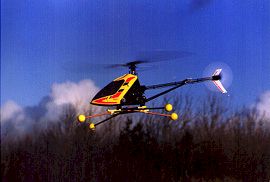
The first thing the new helicopter pilot must understand is that the model works on the same principles as its full-size counterpart and controlling the helicopter is just as difficult, if not more so. Flying a helicopter, just like flying a model aircraft, is a skill that must be learned and that can only happen with practice. Although building and flying a model helicopter can be complex, it is also very satisfying. Being able to accurately control a aircraft that can hover, fly forward, backward, sideways, and do all kinds of interesting manoeuvres and aerobatics, as well as land at your feet, is very enjoyable.
Before you start flying, spend some time with an experienced helicopter pilot. He can help you set up your helicopter (it is extremely important to have the mechanics set up accurately for safe and easy flying) as well as give you some tips on flying; what to expect from your model and how to operate the controls. More information can be found on our Frequently Asked Question for Helicopters.
| How Do R/C Helicopters Fly? |
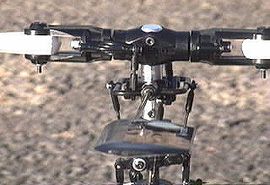 There
are many more moving parts in a collective pitch rotor head and thus,
they are cost more. All current helicopters on the market today have collective
pitch.
There
are many more moving parts in a collective pitch rotor head and thus,
they are cost more. All current helicopters on the market today have collective
pitch.
On a standard, collective pitch helicopter there are four controls and these are operated by five channels of your radio system. These controls are the collective pitch, the fore and aft cyclic pitch, the side to side cyclic pitch, and the tail rotor pitch. The collective pitch must also be coupled with the throttle of the engine so that when more load is put on the main rotor blades by increasing the pitch, more throttle is applied to help overcome the additional drag.
The left stick of your radio transmitter controls the collective and throttle in the vertical direction and the tail rotor pitch in the side to side direction. Your right stick controls both cyclic operations; up and down for fore and aft control and side to side for the cyclic side to side control. There are also mixing functions which mix the throttle and collective functions, and the throttle/collective and tail rotor functions. So, you see it can all become very complicated to set up both the helicopter and the radio!
| Operating R/C Model Helicopters |
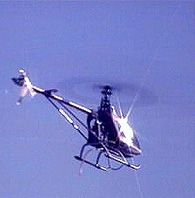 comes
to speed, the clutch engages and begins to turn both tail and main rotors.
Generally, at this point, there is no pitch on the main rotor blades and
thus no lift. The throttle is increased until the main rotor blades are
brought up to speed. To lift the helicopter collective pitch is applied.
comes
to speed, the clutch engages and begins to turn both tail and main rotors.
Generally, at this point, there is no pitch on the main rotor blades and
thus no lift. The throttle is increased until the main rotor blades are
brought up to speed. To lift the helicopter collective pitch is applied.
Because, for every action there is an equal and opposite reaction, when the engine is forcing the rotor blades to turn in one direction, the body of the helicopter will want to rotate in the opposite direction. The function of the tail rotor is to correct this tendency. The tail rotor blades provide enough thrust to the side to keep the helicopter pointing in one direction. By increasing or decreasing the pitch of the tail rotor blades the direction the helicopter is pointing can be changed.
The cyclic control permits the main rotor blades to be varied independently making the helicopter move in a horizontal direction. If one of the rotor blades increases pitch as it approaches the rear while the opposite blade decreases in pitch while approaching the front during its rotation, more lift will be produced in the rear, tilting the helicopter forward, and thus moving the helicopter in a forward direction. The same principle applies for side to side and rearward, allowing the helicopter to fly in any direction.
The control of the cyclic and collective pitch is transferred from the radio servos to the rotor blades via the swash plate. Part of the swash plate is stationary while the other part is allowed to rotate with the rotor head. Control linkage is connected from the servos to the stationary part of the swash plate as well as from the rotating part of the swash plate to the rotor head.
When flying a helicopter, small amounts of control input are continually required by the pilot to correct for deviations in the flight path. 100% concentration is required when flying a helicopter. The more accurately the helicopter is set-up, the fewer the number of corrections are required by the pilot.
| Will It Drop Out Of The Sky If The Engine Stops? |
As the helicopter starts to descend, the air moving through the blades will keep them rotating. The spinning blades will act like a parachute in reducing the helicopters decent. When the helicopter nears the ground, the pilot increases the collective pitch making the pitch of the blades again positive. The momentum of the blades is converted to lift, slowing the descent of the helicopter down further, enabling it to land softly.
| What You Need To Get Started |
The Helicopter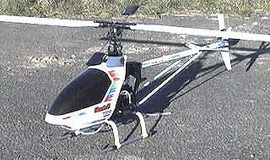
When you choose your first helicopter you will have to decide which type
of helicopter you wish to buy, one with collective pitch, or one with
out collective pitch. If you are starting in radio control for the first
time we would recommend a helicopter with collective pitch. You will also
find the learning process easier with a collective pitch helicopter. You
will only find helicopters in the second hand market without collective
pitch, and we strongly recommend that you stay away from them!
Unlike aircraft where there are specific trainer models geared solely for the first time kit, the differences between helicopters is more subtle with the biggest difference being size and precision. The larger and more precise a machine, the better it will fly. These machines would make great training helicopters but they are usually a lot more expensive, with high precision parts, and would be very costly to repair in the case of a crash. They are better suited for the more experienced modeller where accidents happen less often.
Bare in mind, when learning to fly a helicopter you are going to have a crash or two and parts are going to have to be replaced. Replacing parts on a precision machine could really run you a bill! A good place to start would be a helicopter designed for a .30 size engine, a stable flyer with collective pitch, and one with a good availability of parts.
The Radio
As mentioned earlier, a proper helicopter radio differs from a standard
aircraft radio. There are certain functions that must be mixed electronically
and these are found only in radios designed for this purpose. More and
more often, one is 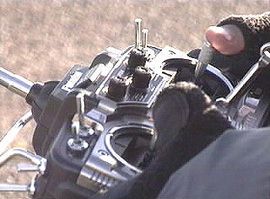 able
to find radio systems that have functions suitable to both aircraft and
helicopters. If you think you may be involved in both sides of the hobby,
you may want to choose one of these for your system.
able
to find radio systems that have functions suitable to both aircraft and
helicopters. If you think you may be involved in both sides of the hobby,
you may want to choose one of these for your system.
Other things to think about when purchasing a helicopter system are the servos and the battery pack. It is best to choose servos that have output shafts supported by ball bearings. The pressure and vibration on the servos in a helicopter is much greater than in a aeroplane, bushed servos tend to wear out very quickly and lose their precision which is extremely important in the controlling of a helicopter. Because you will be using a minimum of five servos and a gyro (to be discussed later) in a helicopter, and the higher frequency of control input, it is very necessary to have a larger battery pack than the standard 600 maH pack that comes with most aircraft radios. A battery pack of 1200 maH is a minimum requirement but 1800 to 2000maH is a much better option to consider. Many helicopter radios come packaged with five BB servos and a large battery pack. Also ensure that the radio is on the 35Mhz waveband and not anything else. This frequency band is specially designated to model aircraft in the UK. Please read ' Getting To Know R/C Radio Systems' for more information on the right radio to buy.
Gyroscope
A gyroscope, or gyro, is an electromechanical device used in a helicopter
to help semi-automate the response of the tail rotor. In the case of an
R/C helicopterr, the device is fitted electrically between the receiver
and the servo that controls the pitch of the tail rotor blades. A sensor
measures any change in yaw of the aircraft and will correct the situation
by increasing or decreasing the tail rotor pitch to stabilise the movement.
We would say that a gyro is essential as the beginner will have enough to do with all the other controls without trying to stop the model from spinning around all the time and with gyros available from around £39 it is money well spent. Gyros are made by most radio manufacturers for operation compatible with their systems.
The Engine
The helicopter engine is similar to a 2-cycle aircraft glow engine except
that it has a larger heat sink head for better cooling, and a carburettor
with improved midrange adjustment. When purchasing the helicopter engine,
the muffler is not included. Usually the muffler comes with the helicopter
kit.
Different motors use different starting methods. Some come with a pull start system for very simple starting. Others use a cone start where an electric starter is used in a similar way as starting an aircraft. Others use an electric starter and a belt for starting. Please read 'Getting To Know R/C Engines'.
Tools
Because the helicopter is purely a mechanical device, tools for assembly
usually include items such as screw drivers, ball drivers, nut drivers,
wrenches, pliers, etc. In addition to these there are a couple of speciality
tools that come in handy when assembling and setting up the mechanics
of your helicopter.
One tool you may want to assist you in assembly is a set of ball link pliers. The ball link is the most popular linkage piece on a helicopter and virtually all helicopterss use them. The ball link pliers greatly help in the removing and adjusting of these links. A second tool that is extremely useful during set-up is the rotor blade pitch gauge. This device can help you line up your rotor blades so that your pitch is correct. A blade pitch gauge can go along way to helping avoid costly crashes and frustration down the road as so much of your chopper's well being depends on how well it is set up initially and maintained throughout its lifetime.
Field Equipment
The field equipment you require will depend largely on the type of motor
you have chosen for your helicopter. If you have a glow motor with a recoil
pull-starter, you will only require the basics of a fuel can and pump
for carrying and pumping fuel to your chopper, and a glow plug battery
to supply power to the glow plug during starting. If you do not have a
pull start, in addition you will undoubtedly need an electric starter
powered by a 12 volt battery to turn the engine over. Please read 'Getting
To Know About Accessories' for more details.